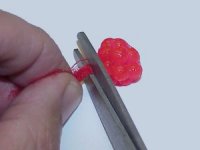Tube Jigging for Trout and Salmon


The technique used for fshing the tube jig setup is easy.
The depth of the tube jig below the bobber or float might need to be adjusted depending on the area you are fishing and the depth of water. Most normally start with the tube jig set 3-4 feet below the surface of the water. Remember the eyes of a trout or salmon look up, not down. In some areas when the trout and salmon are deeper the tube jig can be set to 5-10 ft below the bobber. A Split shot can be added above the SPRO power swivel to help sink the jig faster, but do not add too many as the flutter action of the jig is important. First cast the bobber and tube jig to an area in front of where you are fishing. When the bobber first hits the water wait and watch the bobber. You will see the line move thru the slip bobber and the bobber will twitch slightly when the full weight of the tube jig is hanging vertically. If there is any movement of the float after the tube jig sinks to its position, immediately set the hook. Wait for 5 to 10 seconds. Point your rod tip directly at the bobber and reel up any slack line. When you have a tight line to the float, slightly twitch the tip of your fishing rod. This will cause the bobber to move toward you. The tube jig will lift during this motion and then drop back to a vertical position. The drop might take several seconds, depending how deep the tube jig is set. Again reel up any slack line. Wait for a few seconds and perform the same motion again, and again. If at any time there is abnormal movement in the bobber, quickly lift your rod tip to 90 degrees vertical to set the hook. When fishing near a fishermen using the technique with 10 foot noodle rods, a swishing sound thru the air can be heard followed by someone proudly saying "Fish ON!!!".
The Tube Jigging for Trout and Salmon technique can be used in all open water seasons. It is as effective in spring as well as fall for both salmon and trout. The only time that it is not recommended is immediately after a fish stocking has occurred in an area. The young under size limit fish (smolts) will easily caught and can be easily injured by just handling them. Let them grow.
Purchase the best tube jigs here. Bloop Tubes

































